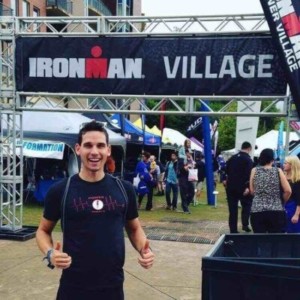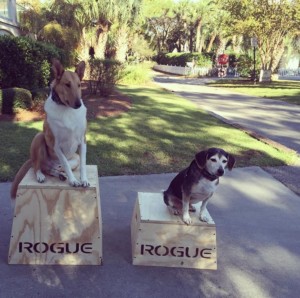By Jeff Ford
When you attend any triathlon event you can quickly tell the athletes who prioritize strength training in their personal plans and those who let it slip away. The slim and skinny often outnumber the lean and strong without question.
Implementing strength training with limited time while factoring in soreness can be quite the science. You have to pick certain movements, understand timing and set up each strength training session so that you’re not taking away from your sport activities. Think about it, is there any chance of you having a successful tempo run the day after a session filled with four hundred squats?
Stop just guessing when you add strength into the schedule. Here’s how to NOT be a weak triathlete and still have pep in your legs and arms for each sport.
You Need to Understand Potent Movements
Judging the success of your workout by how sore you get is pretty short-sighted thinking. Soreness from a workout doesn’t necessarily equate to getting stronger, especially if you’re a triathlete who has to swim, bike and run in conjunction. You have to understand which movements (given their properties) will require the most recovery; strategy is involved.
Classically, most triathletes have very weak posteriors (in the back of their body – think back, hamstrings, glutes and lower legs) due to poor sport mechanics and overall lack of true muscular strength training in favor of high-volume endurance activities. This means that you’ll tend to get increasingly sore with exercises that target your weaknesses. Now this is no reason to avoid these exercises, but requires limiting the overall volume so that you don’t inhibit your swim, bike or run.
Potent movements also include those with high range of motion eccentric contractions; the downward or lowering phase of a strength training exercise. For example in the romanian deadlift, by lowering the weight and keeping your back flat with your hamstrings relatively straight you’re inherently signaling an eccentric contraction. Additionally, the slower you go during this lowering phase increases the likelihood for delayed onset muscle soreness. That said, you won’t be able to run hard the next day if you overdo the deadlifts.
Balancing your strength sessions to meet your sport needs while decreasing the potency at a basic level can be set up as follows:
- Day 1 (let’s say Monday): Squat/Press 3-5 sets of 3-7 repetitions at medium to heavy load or 70-80% of your maximum lift. Move the weights with good form, steady speed and rest 2:00-3:00 between sets.
- Day 2 (let’s say Thursday or at least 48 hours in between): choose a Deadlift/Lunge variation and perform 6-8 sets of 2-3 repetitions at light to medium load or 50-65% of your maximum lift. Move the weights with good form, quickly and rest only 30 to 60 seconds between sets.
Your Focus Should Be Compound Movements
The second factor to becoming the right kind of strong for your sport has to do with a focus on compound or multi-joint movements. You can see by our example training sessions that you’re not programming heavy bicep curl lifts or fast side dumbbell raises; the idea is to pick movements that target many muscle groups and directly relate to your sport.
Don’t get it wrong, you’re not going to neglect supplementary exercises or weaknesses, there’s just a time and place for those in the plan. Compound movements like the squat for cycling and the overhead press for swimming just make the most sense especially for the time-crunched triathlete.
Compound movements force your body to go thru a much greater range of motion, exhibit the shapes of your sport and rely on you to create midline stability. You don’t have to do a bazillion sit-ups to get six pack abs.
When you get stronger pressing overhead, your streamline position in the pool becomes easier to hold because of the number of muscles you’ve taxed during the movement. If you’re an efficient runner, you pull with your hamstrings/glutes therefore leveraging deadlifts and training a box squat will increase strength in the areas of need. Think best case scenario – your schedule allows time for two strength training sessions in a week, doesn’t it make sense to prioritize?
You CAN Combine Strength and Sport
Now besides executing your two main lifts and focusing on compound movements in a training week, your best way to become a stronger triathlete relies on combining your strength work with your sports. Who said brick training can only be done with the bike and the run?
Design at least two sport-specific conditioning routines behind your main lifts. You don’t have to go over the top and make it crazy, but think instinctively; what exercises can you select to challenge your sport?
Part two of your day 1 and day 2 would be designed as follows:
- Day 1 (Monday after your lift): 5 – 6 rounds EACH for time of: 12 Wall Ball Squats 20/14, 200m Run, Rest 1:30. If your legs become fatigued and then you force your body right into an all-out repeat, that should help coming off the bike, you think?
- Day 2 (Thursday after your lift): 3 rounds for reps of: 3:00 Bike Trainer, :30 Rest, :30 Box Jump (step down always to save your achilles), :30 Rest, :30 Hollow Hold, :30 Rest. You’re now training a different energy pathway (given the bike is 3:00), challenging stability of the ankles and feet for the run and challenging ideal posture with the abdominal hollow hold exercise.
You Don’t Have to Be a Rocket Scientist
Whenever you add a new type of training into your plan it can be a little bit intimidating. Have no fear as hopefully you can tell it just takes a little rhyme and reason to piece together a strong plan. As you begin your quest in NOT being a weak triathlete you’re going to get a little sore and understand which movements are particularly potent. By focusing on compound movements and combining sport with strength you’ll quickly see great results.
A strong triathlete isn’t scared to try new things. You understand quickly how to overcome the suffering in your race and within your long training schedule. You just didn’t know that your sport was making you weak. Start today, pick a day, time and a place. One session is all it takes.
This article is originally published in beginnertriathlete.com.

No Comments